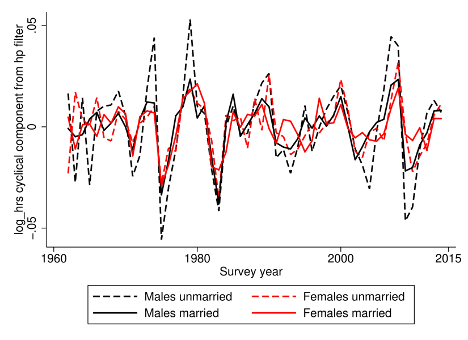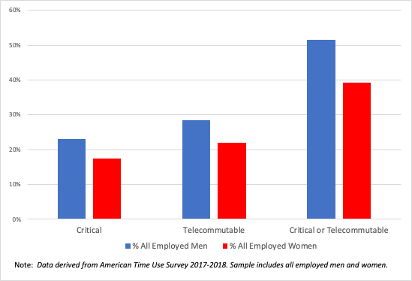Editor’s note: The paper behind this column appears in the fourth issue of CEPR’s new initiative, Covid Economics: Vetted and Real-Time Papers
Initially labelled the ‘great equaliser’, the COVID-19 pandemic is turning out to be anything but. The data show that people’s exposure varies tremendously with factors such as place of residence, income, and race. In this column, we focus on a factor that is arguably even more important, namely, gender. Women and men are affected in different ways by the crisis, and not always in the same direction.
In terms of the direct health impact, men appear to be at much higher risk than women. In New York, for example, men are dying at nearly twice the rate as women from COVID-19 (Rabin 2020). But the pandemic is not just a health crisis; it is also a social and economic crisis, and many of the broader repercussions affect women more severely than men.
There are early reports of rising domestic violence as couples and families are forced to hunker down together (Taub 2020), which puts many women at great risk. In our own work (Alon et al. 2020), we focus on the impact that the economic crisis triggered by the pandemic will have on women and men in the labour market. We show that during the immediate crisis, women’s employment opportunities are likely to be more strongly affected than those of men, but we also point to some long run causes for optimism regarding the impact of the pandemic on gender equality.
This time is different: Gender differences in cyclical unemployment risk
In past recessions, men have faced greater risk of unemployment than women, partly because of the gender composition of different sectors of the economy. A larger fraction of employed men (46%) than employed women (24%) work in construction, manufacturing, trade, transportation, and utilities – highly cyclical sectors that typically suffer during ‘normal’ recessions. On the other hand, 40% of all working women are employed in the government or health and education services sectors compared to just 20% of working men (Coskun and Dalgic 2020).
Another reason men’s employment has typically been more cyclical is spousal insurance: when married men lose their jobs during a recession, their wives can choose to increase working hours or enter the labour force. Doepke and Tertilt (2016) estimate that men accounted for three quarters of all cyclical employment fluctuations from 1989-2014. Figure 1 shows that men generally experience more cyclical employment than women (the sector channel), and that married women have the lowest cyclicality of all groups (the spousal insurance channel).
Figure 1 Employment cyclicality of men and women by marital status
Notes: Data on average weekly work hours for the US (cyclical component is deviation from Hodrick-Prescott trend, smoothing parameter 6.25). Source: Doepke and Tertilt (2016) using data from Current Population Survey, March, and Annual Social and Economic Supplements, 1962 to 2014.
The current downturn caused by economic closures to halt the spread of the coronavirus is different, because different sectors and occupations are being affected than in a typical recession.
We assess whether each occupation is exposed to elevated unemployment risk during the COVID-19 crisis based on two factors:
- whether an occupation is considered critical and thus not affected by stay-at-home orders, and
- whether the nature of the work in the occupation allows for telecommuting.
Those who are not in critical occupations and who are unable to telecommute because of the nature of their occupation are more likely to be laid off during the current recession. Figure 2 illustrates that a greater share of men (52%) than women (39%) work in telecommutable and/or critical occupations, suggesting that women are more exposed to unemployment risk during this crisis than in past recessions.
Figure 2 Share of men and women in critical and telecommutable occupations
Notes: Data derived from American Time Use Survey 2017-2018. Sample includes all employed men and women. Telecommutable occupations are those for which 50% or more of workers reported being able to telecommute.
Employment indicators from the crisis so far bear out our predictions: jobs held by women accounted for around 59% of the payroll decline in March 2020 (Bureau of Labor Statistics 2020).
Job loss during a recession has durable, negative effects on future earnings and job security (Davis and von Wachter 2011, Jarosch 2015). The high exposure of women to employment loss is therefore likely to put upward pressure on the average gender wage gap for years to come.
School closures and time spent on childcare
Childcare poses an additional challenge to working parents during the crisis. Schools and daycare centres have closed, and grandparents have been discouraged from providing childcare due to the risk of exposure to the virus. This leaves childcare duties solely to parents.
Single parents will face the greatest challenge. In the US, 19 million children live with single parents, and 70% of single parents are single mothers (US Census Bureau 2019). Without access to paid leave from their employers, many single parents will be forced to quit their jobs to care for their children. According to our analysis of the American Time Use Survey, only 20% of single parents reported being able to telework compared to 40% of married people with children.
In two-parent households where only one parent works in the formal labour market, the stay-at-home parent, usually the mother, is likely to assume primary childcare duties during coronavirus-related school closures. However, in 44% of married couples with children, both spouses work full time. These dual-earner couples will have to decide how to split the increased childcare demands. Among these couples, mothers already perform about 60% of childcare: men do 7.2 hours of childcare per week versus 10.3 hours for women. If this division persists during school closures, working mothers will bear the brunt of the increase in childcare needs.
Flexible work arrangements and changing social norms: Causes for optimism
While the evidence suggests that women’s employment opportunities will suffer severely during the crisis, we also see causes for optimism over the longer term. In response to the pandemic, many businesses are adopting work-from-home and telecommuting options on a wide scale for the first time. If these arrangements persist, they will disproportionately benefit working women, who struggle to combine their careers with childcare needs. Indeed, Goldin (2010) identifies lack of flexible work arrangements, especially in business and financial services jobs, as one of the biggest remaining sources of the gender pay gap.
Moreover, we predict a potential shift in social norms in a crisis that forces fathers – including managers and CEOs – to come to terms with the childcare needs of their own families. In a time when children walking in on the video calls conducted in home offices becomes an everyday experience, pretending that having a career rules out having family responsibilities becomes less sustainable.
Particularly important for potential cultural shifts are the families in which the crisis will turn fathers into the primary childcare providers. This will be the case, for example, in families where the mother is a critical worker (such as doctor, nurse, or grocery store clerk) and the father is not a critical worker and is able to work from home (such as most office workers). Based on data from the Current Population Survey and the American Time Use Survey data on telework, we estimate that about 9-12% of all couples are in this group.
While this group is a minority, it still comprises millions of households: it will be much more common to see fathers acting as primary caregivers during the crisis than it was before. Past experience shows that shifts in family arrangements induced by crises or policy changes can have long term effects. For example, WWII necessitated substantial temporary changes in women’s labour force participation that persisted after the war (Acemoglu et al 2004, Goldin and Olivetti 2013), and policy experimentation with paternity leave suggests that even short windows that engage fathers can bring about long term changes in the division of childcare responsibilities (Farré and González 2019). Given the magnitude of the changes in childcare arrangements induced by the current crisis, substantial future shifts in social norms are highly likely.
Policy options and conclusions
Even though we point out a long-run upside for gender equality, the short-term policy challenge is to deal with the immediate consequences of the current downturn, which we argue will fall disproportionately on women. We suggest the following policy actions:
- Government subsidies to replace 80% of pay for workers who need to provide childcare during the crisis, conditional on a continued employment relationship.
- Work requirements for government assistance programmes such as Temporary Assistance for Needy Families (TANF) and Medicaid should be removed until school and daycare centres re-open, and time off work now should not count towards future work requirements.
- Unemployment benefits should be extended to workers voluntarily separating from employment to provide childcare.
- Universities should extend tenure clocks for faculty members with children under the age of 14, with similar provisions for other employers with up-or-out promotion systems.
Wherever possible, the best option is to allow working parents, especially women, to keep their jobs. Job loss, particularly during a recession, can leave ‘economic scarring’ that reduces earnings and promotion opportunities for many years. For women who are able to continue working, employers such as universities should explicitly account for the need for increased flexibility to perform childcare in tenure and promotion systems. For those who lose their jobs, unemployment insurance and other government assistance programs should take into account childcare needs that prevent parents from seeking new jobs while schools are closed.
References
Acemoglu, D, D Autor and D Lyle (2004), “Women, War, and Wages: The Effect of Female Labor Supply on the Wage Structure at Midcentury”, Journal of Political Economy 112 (3): 497–551.
Alon, T, M Doepke, J Olmstead-Rumsey and M Tertilt (2020), “The Impact of COVID-19 on Gender Equality”, Covid Economics: Vetted and Real-Time Papers, Issue 4, London: CEPR Press.
Bureau of Labor Statistics (2020), “The Employment Situation--March 2020”, Tables B-1 and B-5, USDL-20-0521.
Coskun, S and H Dalgic (2020), “The Emergence of Procyclical Fertility: The Role of Gender Differences in Employment Risk”, CRC TR 224 Discussion Paper Series No. 142.
Davis, S and T von Wachter (2011), “Recessions and the costs of job loss”, Brookings Papers on Economic Activity 2:1–72.
Doepke, M and M Tertilt (2016), “Families in Macroeconomics”, Handbook of Macroeconomics Vol. 2: North Holland.
Farré, L and L González (2019), “Does Paternity Leave Reduce Fertility?”, Journal of Public Economics 172:52-66.
Goldin, C (2010), “How to achieve gender equality”, The Milken Institute Review.
Goldin, C and C Olivetti (2013), “Shocking Labor Supply: A Re-assessment of the Role of World War II on Women’s Labor Supply”, American Economic Review 103(3): 257-62.
Jarosch, G (2015), “Searching for Job Security and the Consequences of Job Loss”, Unpublished Manuscript: Princeton University.
Rabin, R C (2020), “In N.Y.C., the Coronavirus Is Killing Men at Twice the Rate of Women”, New York Times, 7 April.
Taub, A (2020), “A New Covid-19 Crisis: Domestic Abuse Rises Worldwide”, New York Times, 6 April.
US Census Bureau (2019), “America’s Families and Living Arrangements: 2019”.









